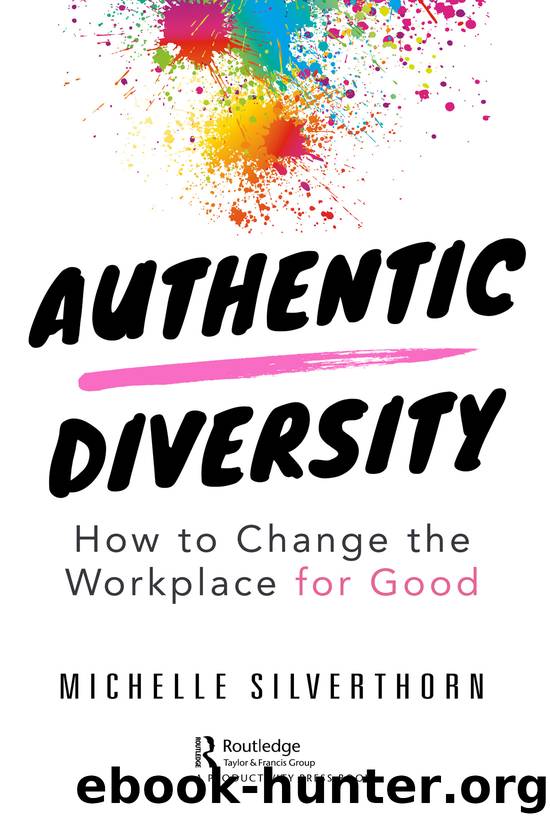Authentic Diversity by Michelle Silverthorn

Author:Michelle Silverthorn
Language: eng
Format: epub
ISBN: 9780429663031
Publisher: Taylor and Francis
What Stereotype Do You Have of Me?
The idea of stereotype threat originated in 1995 with researchers Claude Steele and Joshua Aronson. Stereotype threat happens when people enter a situation where they feel at risk of conforming to stereotypes about their social group. They become anxious about their performance and fail to perform to their full potential. Even if someone doesnât ascribe to the stereotype, they will feel stress knowing that others believe that stereotype about them, particularly in situations where that stereotype is relevant. As researchers Loriann Roberson and Carol T. Kulik note, âEvery employee walking through the door of the organization knows the stereotypes that might be applied to him or her and wonders whether organizational decision makers and co-workers will endorse those stereotypes.â1
Hereâs a practical example. Researchers divided participants into different groups of three â three women, two women and one man, and one woman and two men â then asked them to complete math exercises. In the two groups that included men, the women performed far worse than the women in the all-women group did.2 Another example: when researchers described a golf game as a test of natural athletic ability, Black students performed better than White students. But when researchers described the exact same game as a test of sports intelligence, White students performed better than Black students.3 Itâs a similar finding to what Steele and Aronson found when they did their seminal study on stereotype threat and told one group of students that the test was for intelligence but told the other two groups of students that this exact same test was simply a challenging verbal test. Black students did worse when they believed the test was for their intelligence but far better when they believed the test was for verbal problem-solving skills.4 Why? Because in America, there is an ugly, negative stereotype about Black people and intelligence. The students had internalized that negative stereotype. The same stereotype does not exist about Black people and athletic ability or Black people and verbal problem-solving skills.
Where does stereotype threat leave Jasmine? She doesnât take on the high-risk assignments because sheâs worried that if she struggles or fails, it would reinforce the stereotype that already exists about her lack of competence. She frets in her interview when asked about her background, which makes her come across as fake and stilted instead. Sheâs anxious in her performance reviews and tries to cover it up by projecting indifference. She overcompensates again and again to make up for a stereotype over which she has no control. Thatâs half of the mud that keeps slowing her down.
Download
This site does not store any files on its server. We only index and link to content provided by other sites. Please contact the content providers to delete copyright contents if any and email us, we'll remove relevant links or contents immediately.
Storytelling for dummies by Andrea Fontana(1493)
Effortless by Greg McKeown(1434)
The Practice by Seth Godin(1404)
Mastering Blockchain by Lorne Lantz(1392)
Blockchain Quick Reference by Paul Valencourt & Samanyu Chopra & Brenn Hill(1149)
Mastering Blockchain by Lorne Lantz & Daniel Cawrey(909)
The wind in the willows by Kenneth Grahame(851)
How to Lead by David M. Rubenstein(823)
The Ape in the Corner Office by Richard Conniff(792)
Social Media Engagement For Dummies by Aliza Sherman(711)
Handbook of Big Data Analytics by Unknown(711)
Taking Care of Yourself (HBR Working Parents Series) by Harvard Business Review(698)
Getting Started with Data: The first book you should read to successfully get along with data. by Menegatti Gabriel & Team Simbiose Ventures(693)
FunRetrospectives: activities and ideas for making agile retrospectives more engaging by Paulo Caroli & Tainã Caetano Coimbra(691)
Business Storytelling For Dummies by Unknown(670)
Evernote for Self Publishing: How to Write Your Book in Evernote from Start to Finish by Jose John(667)
Help! My Facebook Ads Suck-- by M. D. Cooper & Jill Cooper(653)
A Leader Listens by Ajay Banga(639)
Genius by Choice: Your unconventional A–Z handbook to enhance your learning process by Remondino Giulia S(638)
